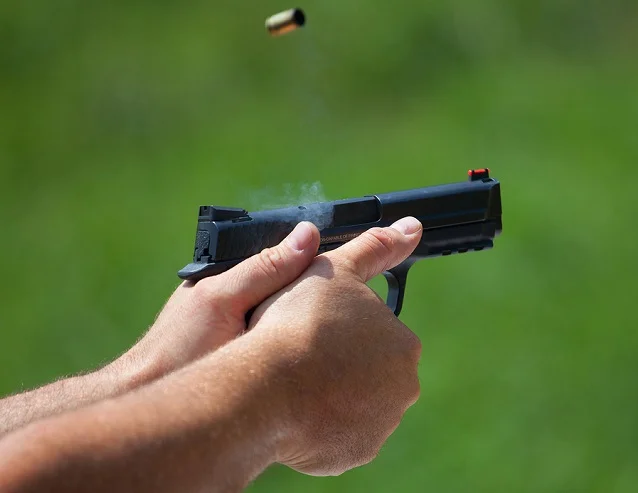
Which is better for concealed carry and other purposes, 10mm vs .40? Should you go with Diet 10mm, or just go ahead and get the full strength version?
10mm gives you more versatility, but is less concealment-friendly due to requiring a larger frame. The benefits of .40 are that you get incrementally more power more than 9mm, but not so much that it matters in the real world and can get much smaller pistols in the .40 S&W chambering.
Ultimately, what you shoot better is the better choice, but let's get into it.
40 Cal vs 10mm: History

We first get into 40 cal vs 10mm by reaching into the pages of history.
The 1986 Miami shootout prompted the FBI to change standard duty weapons, and their ammunition tests indicated 10mm Auto had the most potential. Agents didn't care for it much, partially due to the stiff recoil and partially due to the larger frame required for the 10mm round.
A seasoned handgunner doesn't find it difficult (Bog-standard 10mm feels like a slightly snappier .45 ACP to me, but others may feel differently) but the typical FBI agent and indeed the typical LEO in general has little firearms experience when they join the force.
According to Chuck Hawks Handgun Recoil Table, a 2.25-lb pistol shooting a 180-grain 10mm Auto cartridge at 1295 fps (basically the original loading) produces 11.4 ft-lbs of recoil, roughly equal to a medium-power load in a 4-lb .44 Magnum. A 1.5-lb .40 S&W pistol produces around 10 ft-lbs of recoil for most loadings, double that of 9mm.
As a compromise, the FBI down-loaded 10mm to slightly less than Cooper's original specifications, around 975 to 990 fps and just under 400 ft-lbs of energy.
Smith and Wesson, whom the FBI contracted to supply Model 1076 pistols as their new duty weapon, noticed the case could hold the same reduced-power propellant charge if trimmed from 25mm to 22mm. The new case length could also be employed in a 9mm-frame pistol, making it easier for agents with smaller mitts. Thus, the .40 S&W was born.
10mm vs 40 Ballistics

10mm vs 40 ballistics can be classified thusly: they're the same unless 10mm is loaded to its full potential.
40 S&W is available in grain weights from 60 grains to 205 grains, with 155-, 165- and 180-grain bullets being most common. Typical output is 1150 fps and 450 ft lbs of energy with lighter-weight loadings to around 990 fps and 400 ft-lbs in the 180-grain loads. Overpressure ammunition (.40 S&W +P) adds about another 150 to 200 feet per second and maybe another 30 to 40 ft-lbs of energy.
Modern 10mm Auto ammunition is mostly the reduced-power FBI load. It's literally just .40 S&W in a longer case. Maybe you get an extra 50 fps, but that's it.
However, 10mm Auto loaded to full potential is a different animal.
The original 10mm Auto load, as envisioned by Jeff Cooper (who helped develop the round) was a 200-grain projectile at 1000 feet per second and producing 444 ft-lbs of energy. Norma Ammunition developed the first factory loads, but exceeded Cooper's ideal by pushing the 200-grain projectile to 1200 fps and 635 ft-lbs, with 175- and 165-grain projectiles pushed to 1300 fps and 1400 fps, respectively.
Modern hot loads still pack serious wallop. For instance, Underwood Ammo (the 10mm specialists) produces a number of full-power 10mm loads. Examples include a 180-grain load at 1300 fps and 676 ft-lbs of energy with a Speer Gold Dot JHP, a 200-grain loading with a Hornady XTP JHP at 1250 fps and 694 ft-lbs, and 220-grain hardcast lead flatnose at 1200 fps and 703 ft-lbs of energy. Buffalo Bore loads include a 180-grain JHP at 1350 fps and 728 ft-lbs, a 155-grain load with Barnes TAC-XP JHP projectiles at 1350 fps and 627 ft-lbs, and a 220-grain hardcast outdoor load duplicating Underwood's.
By comparison, Remington's HTP .357 Magnum 158-grain jacketed soft point load produces 1235 fps of velocity and 535 ft-lbs of energy, and their .41 Magnum JSP produces 1300 fps of velocity and 788 ft-lbs of energy. Granted, the upper limit of .41 Magnum is much higher; one Underwood Ammo loading of .41 Magnum, for instance, produces 1560 fps and 1135 ft-lbs with a 210-grain Nosler JHP.
The question, though, is whether it matters in the real world.
40 S&W vs 10mm For Concealed Carry

If you're weighing .40 S&W vs 10mm for concealed carry...the answer is you should get a 9mm instead, unless you A.) just really want a .40 or a 10mm just because or B.) have a practical use for one.
What?!
The truth about self-defense shootings is that handgun caliber basically doesn't matter. Accuracy matters more. Also 9mm doesn't beat on the wrists and is much cheaper, which is why police departments and federal agencies have been dropping .40 S&W like a ton of bricks lately. It's easier to get accurate, stay that way, and easier on you and your wallet.
For range ammunition, a box of 9mm ammo costs $10 in most stores. A box of .40 S&W costs $15. A box of 10mm? $20 or more, for a box of 50 FMJ rounds. IF, that is, they have any.
Modern handgun ammunition has rendered moot the caliber wars. So long as you carry a quality bullet and put it where it needs to go, it makes no difference if it's 9mm, .40 S&W or .44 Magnum.
At this stage in the game, the only real reason to get a .40 S&W unless you just like it (and go right ahead!) is that it qualifies for Major Power factor competitive shooting events, and is cheaper than .45 ACP. There is no other practical reason. If you like it and shoot it well, by all means, but that's about it.
However, 10mm makes a case for itself as being the Swiss Army Knife of handgun calibers. You can do literally everything with it. It's a good defensive caliber. It's great for competition. It's great for handgun hunting up to medium game. If you want a backup gun for the woods, 10mm is very popular in bear country; while some argue about bear spray vs gun, a 10mm is very viable for the purpose and is a favorite among Alaskans.
10mm, therefore, can go from the hood to the wood, so to speak.
As to pistols, .40 S&W is offered in all size classes. While fewer manufacturers are offering .40 S&W pistols (because people aren't buying them as much anymore) there are still plenty out there. You can get a big gun, a compact gun, or a little gun. Be ready, though; small pistols in .40 S&W have snap.
However...you CAN score a serious deal on a police trade-in gun. Agencies are shedding .40 pistols like crazy, and - just to throw this out here - that Glock 22 or M&P40 can be fitted with a conversion barrel.
10mm is not really offered in any subcompacts, due to requiring a larger frame. However, you can find some compacts; EAA/Tanfoglio offers some compact 10mm pistols, Glock has a couple and then you can find the odd 10mm Commander, such as the Rock Island Armory TAC Ultra MS.
In other words, be ready to carry a bigger gun.
10mm Vs 40: The Nitty Gritty

The gist of it is this: 10mm vs 40 really comes down to what you're going to use it for.
For general shooting pleasure and/or concealed carry...the truth is that you're probably better off with a 9mm. You'll enjoy shooting it more, and you have a plethora of choices of handguns that are very easy to carry every day in your concealed carry holster. And it's cheap!
Unless you shoot Major Power events, there basically is no reason to have a .40 S&W. There is literally no other benefit to it that matters in the real world.
If you want to use one pistol for literally everything, 10mm is without peer in this regard. Only .45 Super comes close, and that round has basically no support in the market. However, having to carry a compact-to-full-size gun is a turn-off for a lot of people.
Ultimately, though...it really comes down to what you like and what gun YOU can run the best. If that's a .40, awesome. If it's a 10mm, awesome.
If it's a 1911...so much the better.










